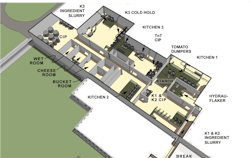From Industrial Kitchen Revamp to S88-based Configuration Tool
It all started with the ISA-88 batch control standard and the necessity to meet the needs of an extremely challenging project: Consolidate and reconfigure three kitchens housing 70 kettles (tanks) in an existing area of a large food processing facility without shutting down the 24/7 operations of the plant—and do it in 10 weeks.
The system integrator who took on the challenge was ECS Solutions of Evansville, Ind., a CSIA Certified integrator and Rockwell Automation Authorized System Integrator. The result was the delivery of all hardware, software and procedures in the allotted time. To get there, ECS designed a tool to speed up the process: S88 Builder. It is now not only something ECS can use to create systems for its next client, it is also a packaged solution that can empower manufacturers of all kinds to get new batch management systems installed quickly and modify them more easily.
“A lot of integrators have come up with ways to hide programming,” says Randy Otto, vice president of ECS Solutions. “We eliminated it completely—for ourselves and our customers.”
Otto says S88 Builder is the first control system to enable users to configure process devices such as valves, pumps, variable drives or tanks, and then configure these devices into specific operating tasks such as mixing, flow control, heating, cleaning, etc. The configuration process is easier, more accurate and faster than programming devices and tasks: “It has proven to reduce project development by up to 90 percent compared to custom programming,” he says.
The project involved clearing the area in kitchen 3 in order to install new kettles, then demolishing kitchens 1, 2 and 3 in stages as new kettles were brought online. The new operation included the 70 tanks/kettles, five clean-in-place systems, 120 variable frequency drives and 1,200 mixer and transfer valves. ECS’s scope of supply included programmable logic controllers (PLCs), motor controls, operator terminals, instrumentation, solenoid valves, and network server hardware and related software to control and monitor the operation. It also included the design and construction of the control cabinets: control panels, 16 motor panels, 50 valve panels, eight PLC panels and 13 operator panels.
The development schedule—from functional specification to panel fabrication and installation—was 10 weeks; the commissioning schedule for the phased implementation of the new control system allowed for one week of production trials for the first 12 networked kettles, and 10 weeks for the remaining 58.
The physical equipment was piped in what S88 refers to as a network structure, allowing campaigns of several products to run concurrently. “We could also clean any tank while the adjacent tank kept running. It was a really complex control system,” said Otto. “We had to design a lot of flexibility into the system.”
ECS Solutions developed S88 Builder to speed development and gain flexibility. It takes the ideas embodied in the ISA-88 standard to a whole new level.
“In my opinion, we have made the control and equipment modules truly atomic elements,” explains President Tim Matheny. “S88 Builder Studio, which is an SQL database, contains various modules to configure devices and tasks on a PC. We take task lists and instrument lists from P&IDs and define agitators, pumps and valves. For tasks, we don’t stop at phases as a typical batch management system does. We go down to the control module level and we define functions in those modules. We’ve extended what a batch management system can do into the controller itself.”
S88 Builder Studio loads all those profiles and relationships onto a PLC/PAC that contains the S88 Builder engine, which provides the runtime execution of those profiles. S88 Builder also incorporates faceplates and objects tools installed in an HMI to provide operator interface capabilities, including task status, alarms and task management.
“We are not creating a custom program,” says Matheny. “We are executing a non-custom program [the PAC “engine”] according to the physical parameters of any given system and configuring recipes.”
“We’ve had a lot of customers who need a standard solution for each process and plant, a consistent and standard control system,” adds Matheny. “There is no more standardized approach than S88 Builder.
The S88 Builder solution was announced in May. It currently is compatible with Rockwell Automation PLCs/PACs, HMIs and batch management and visualization software, but support for additional brands of hardware and software are under development.
>> For more on the ISA-88 batch control standard and how it's enabling both standardization and flexibility, see "ISA-88: Better Batches Every Time" in the June 2013 issue of Automation World.
About the Author
Renee Bassett
Managing Editor

Leaders relevant to this article:
